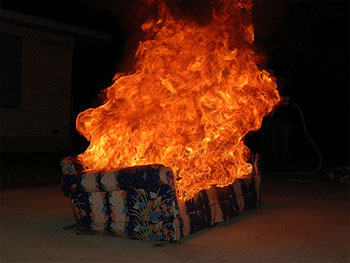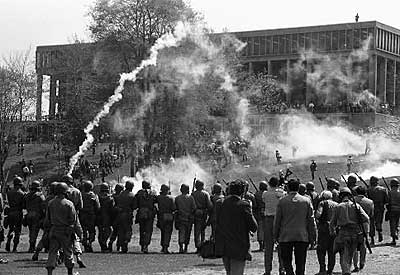Over the past few decades, the three things that have been typically associated with the outbreak of a riot in the U.S. are race, war, and sporting events (celebratory riots). With all of the political opinions and team spirit prevalent on a college campus, it's easy to see why so many riots do take place on or near college grounds.
Recommended Resources:
The 7 Biggest College Riots of All-Time
Here we take a look at some of the most significant college riots in U.S. history.
Bonus: Also see college traditions that were banned because they got too out of hand.
7. University of Maryland – April 1-2, 2002
How it Started:
The University of Maryland defeated Indiana to claim title to the NCAA men's basketball championship. It was Maryland's first ever college basketball title and the victory sent fans into a frenzy. An estimated 5,000 hit the streets in celebration. Fueled by excessive alcohol consumption, the mob lit trash cans and couches on fire and started overturning objects in the street.
The Aftermath:
Following the celebratory riot, 17 people were arrested, 6 police cars were damaged, over 16 fires had been set, two dozen were injured, and a Maryland state trooper was hit in the face with a plank. A night of bonfires, looting, drunken brawls, flying beer bottles and hundreds of troopers in riot gear caused roughly $50,000 in damages. The rioting was so bad, university officials later established a zero tolerance anti-rioting rule, meaning a student could be expelled if caught in acts of vandalism or violence after games.
Maryland, who has a history of rioting, had a similar riot a year earlier in a Final Four loss to Duke, when a bonfire set by fans caused $500,000 in damage. Rowdy fans smashed out storefronts, attacked police, and set fire to a mobile home.
6. Iowa State University – April 17-18, 2004
How it Started:
It was the week of VEISHEA, an annual week long celebration held each spring on the campus of Iowa State University in Ames, Iowa. Students created VEISHEA over 80 years ago and has since evolved into the largest campus celebration in the nation.
On Saturday night, April 17, police received a complaint of a party that was spilling out into the street. Police responded and proceeded to break up the 400-person party in the campus district. The partygoers filled the streets, joining forces with another large group who was already in the streets for VEISHEA festivities. Altercations rose to riot intensity with hundreds crowding the streets and taunting police by mooning them and shouting phrases such as "F*ck the police" and "No dry Veishea." Police were armed with pepper spray and tear gas.
The Aftermath:
Police and about 2,000 rioters clashed until almost 5:30am. Lamp posts, street signs, parking meters and many storefront windows were damaged or destroyed. 16 officers and 22 civilians suffered injuries, some due to falling lamp posts. 37 arrests were made, including assault of an officer, criminal mischief, disorderly conduct and interference with official acts. The night ended with nearly $250,000 in damages to public and private property.
Many involved in the riots claimed they were victims of police brutality, saying they were sprayed with gas for no reason. 42 complaints were filed against police who pepper sprayed and tear gassed people trying to leave the area and against officers who acted overly aggressive in attempting to control crowds.
Some blamed the previous six years of an alcohol-free VEISHEA as the cause of the riots, and these acts of violence were merely built up aggression. 2005 marked the first time in 82 years that VEISHEA was not held.
5. Ohio State University – November 23, 2002
How it Started:
It was what is known as the greatest rivalry in college sports: The Ohio State vs Michigan football game. Fans spent the day waking up in the morning for 'Kegs and Eggs', and continued tailgating until game time. There was much media hype of the event, as the game meant a lot. There was a huge crowd in attendance, with many Ohio State fans sporting vulgar anti-Michigan T-shirts. Ohio State ended up defeating arch-rival Michigan 14-9, clinching a berth into the National Championship game, and giving Ohio State a perfect 13-0 record on the year. Fans rushed the field after game, a few getting broken legs in the process.
After the game...
Every house on campus was throwing parties that spilled over into the streets. It was just a matter of time before things got out of hand.
A car tried driving through mobs of people on the street and made the mistake of honking his horn. In a matter of seconds the windshield was smashed in with a rock and the passengers were pulled out of the car and beat. The people in the car ran away as the crowd rocked the car back and forth until the vehicle rolled over.
Chaos ensued from there....
One car after another was being flipped over all down the street. Cars were set ablaze, then furniture. Police then hit the streets with riot gear. Dozens of tear gas canisters were fired into the crowd, scattering thousands of rioters in each direction.
The Aftermath:
The crowd of over 5,000 managed to start 107 fires, damage 20 cars, and produce massive amounts of trash on the streets of Columbus. 70 arrests were made with charges ranging from underage drinking to public indecency to resisting arrest.
Many say the cause of the celebratory riot was the excessive drinking that many fans took part in. Because of the all-day drinking binge, there were many “falling down” drunks.
That night in Columbus was a war zone: people were flipping cars over and lighting them on fire, uprooting trees and ripping doors off of houses to fuel the fires, and tear gas was being dispersed everywhere while the crowd was being shot at with rubber bullets.
4. Michigan State University - March 27, 1999
How it Started:
After the Michigan State basketball team lost to Duke University in the NCAA Final Four, approximately 5,000 students and fans gathered on the outskirts of campus. The crowd began burning couches, fueling the fires with anything burnable. Revelers were jumping over bonfires, throwing bottles, and set flame to a Chevy Nova.
Police marched in with riot gear releasing canisters of tear gas, forcing the crowd to move to another location. As the mob moved around, store window fronts were bashed in, including a Taco Bell window where a student made himself a taco. More looting ensued from there.
The Aftermath:
Police finally gained control of the situation at 5am, 300 canisters of tear gas being used in the process. The riot was a huge national media story, grabbing headlines and prime time coverage from major news outlets. 8 cars were turned over and burned, 61 fires were set, trees were uprooted and traffic signs were destroyed. Approximately 130 people were convicted for their involvement in the riot, two being charged with arson. Actions from the chaotic night caused more than $500,000 in damages.
Michigan State has a history of civil disturbances. The insanities that took place that night were a clear embarrassment to the university and those associated with it. The rioting at Michigan State set the tone for post-game antics at many college campuses. It started a trend that is seen year after year at campuses across the nation.

3. Ole Miss Riot of 1962
How it Started:
In the Federal government's attempt to desegregate the college, court orders demanded the enrollment of black student James Meredith at the University of Mississippi. The Governor of Mississippi denied federal orders to admit the student as he wanted the university to remain segregated. Despite resistance from the state, on October 1, 1962, James Meredith became the first African American student admitted to the University of Mississippi.
The Aftermath:
6,000 troops were sent in to control the riots that broke out. Two people were killed, hundreds were injured, and nearly 200 arrests were made. 35 US Marshalls were shot in the attempt to admit the student. The conflict was considered the biggest crisis in the South since the Civil War. The enrollment of James Meredith marked a turning point in the civil rights movement.
2. Jackson State - May 14-15, 1970
How it Started:
A group of student protesters were protesting on the campus of Jackson State. This was during a time of heavy antiwar and civil-rights protests.
There was much racist hatred going on, as cars would drive by protesters yelling racial obscenities, while protesters fired back by throwing rocks at cars passing by. The atmosphere of racism escalated when a large group of African American students started fires and overturned vehicles. Police attempted to control the crowd while firemen put out the fires.
The rioting crowd of about 100 began hurling bricks at officers and yelling obscenities. Police advanced forward to disperse the crowd, firing shots in the process. Upon shots, the crowd scattered, people being trampled in the process.
The Aftermath:
Two students were killed and twelve others were wounded. The injured students, many of whom lay bleeding on the campus grounds, were taken to the hospital, but not until after police picked up all their shell casings.
The exact cause of the shooting and the moments leading up to it are unclear, as there were conflicting accounts of what actually happened. The students say that the police were not provoked, as no policemen were injured.
Police fired more than 460 rounds into the crowd. Many of these bullets hitting campus buildings; bullet holes that can still be seen to date.
The Jackson State killings happened 10 days after National Guardsmen killed four students in similar protests at Kent State University.
1. Kent State – May 4, 1970

How it Started:
On April 30, President Nixon announced to the nation that the U.S. was moving forward with an invasion of Cambodia. Many students on the Kent State campus began protesting, demonstrating their opposition to the war.
The few days preceding May 4, there was constant protesting and rioting going on, which included burning bonfires, destroying store window fronts, and setting fire to the ROTC building on campus. The city of Kent was declared a state of emergency and the National Guard was sent in.
On May 4, Kent State protesters continued on with plans for an organized demonstration against the war. 77 National Guardsmen marched forward to disperse the crowd. The National Guard opened fire, firing 67 rounds over a period of 13 seconds.
The Aftermath:
The Kent State massacre, as it came to be known, involved the shooting of unarmed college students by members of the Ohio National Guard. Over the course of the 4 days of protesting, tear gas, bayonets, and gunfire were all used to “control” the crowd. Four students were killed and nine others were wounded, some of the victims being students who were merely passing by or observing the protest from a distance. The question of why the shots were fired remains widely debated.
There was a significant national response to the shootings and it further divided the country. The shootings sparked up similar protests on other college campuses. A nationwide 'student strike' began causing more than 450 campuses across the country to close, totaling about 8 million students. The Kent State campus remained closed for six weeks.